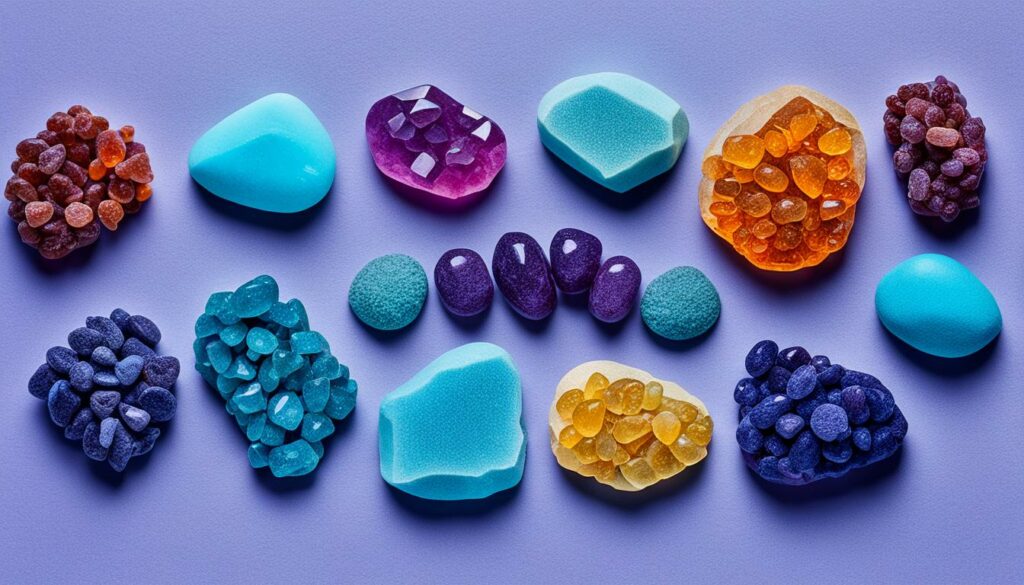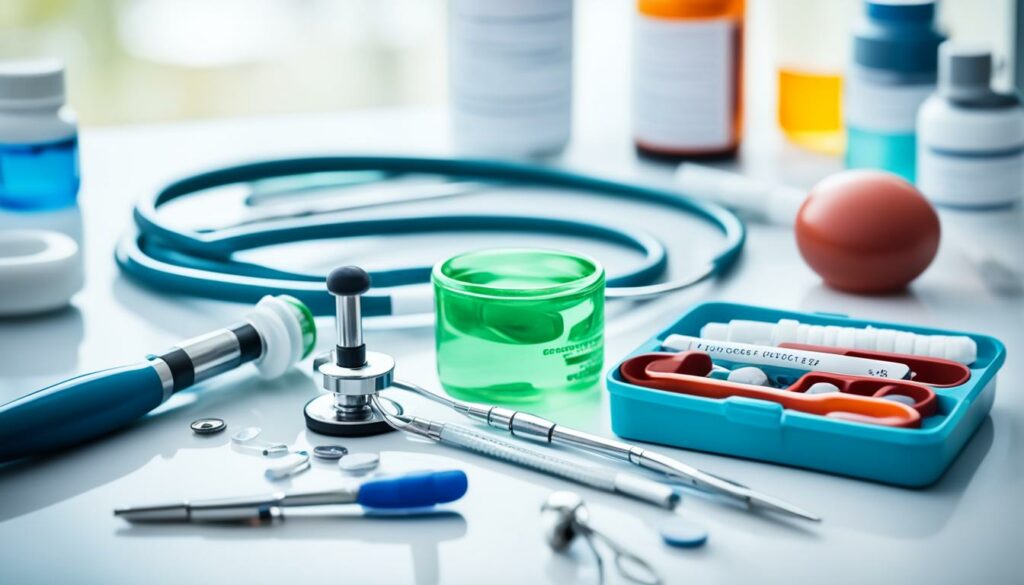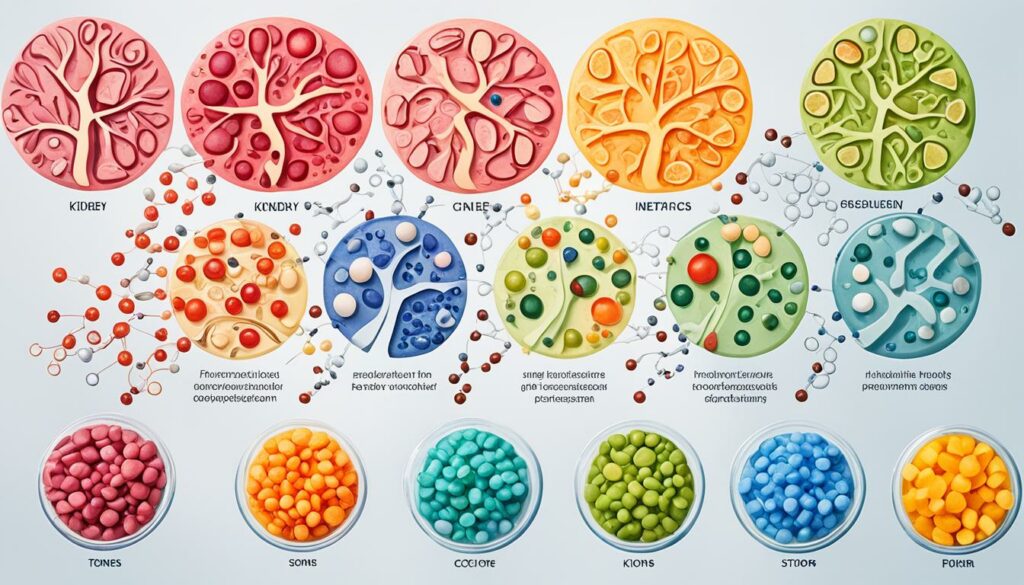Can Teens Get Kidney Stones? Risk & Prevention Tips
Kidney stones are not just a concern for adults. In fact, over the past two decades, the prevalence of kidney stones in children and teenagers has been on the rise. In the United States, most kidney stones occur in teens, making it essential to understand the risk factors, symptoms, and prevention strategies surrounding kidney stones in adolescents.
Kidney stones can form when minerals and other substances in urine combine and create hard stones. The most common types of kidney stones in U.S. children are calcium oxalate and calcium phosphate stones. Several risk factors contribute to the formation of kidney stones in teens, including a family history of stones, a high-salt and low-fruit/vegetable diet, low urine output, certain medical conditions, medications, blocked urine flow, and a lack of physical activity.
Key Takeaways:
- Teens can develop kidney stones, and the prevalence has been increasing in recent years.
- The most common types of kidney stones in teens are calcium oxalate and calcium phosphate stones.
- Risk factors include family history, diet, low urine output, specific medical conditions, medications, blocked urine flow, and lack of physical activity.
- Kidney stones can cause severe pain and other symptoms, and diagnosis is usually confirmed through imaging tests.
- Treatment options range from self-care measures to medical interventions, depending on the size and severity of the stones.
- Prevention strategies include increasing fluid intake, making dietary changes, and maintaining a healthy lifestyle.
- Climate change and dehydration can also contribute to the risk of kidney stones in teens.
Types of Kidney Stones in Teens

In teens, kidney stones can develop in different forms, depending on the composition of the stone. Understanding the different types can help healthcare professionals develop effective prevention strategies. The most common kidney stones in U.S. children include:
- Calcium Oxalate Stones: These are the most prevalent type of kidney stones and are formed when calcium combines with oxalate in the urine. Certain factors, such as a high oxalate diet or a medical condition that increases the level of oxalate in the urine, can contribute to their formation.
- Calcium Phosphate Stones: Similar to calcium oxalate stones, these occur when calcium combines with phosphate in the urine. A diet high in animal protein or certain medical conditions can contribute to their development.
- Uric Acid Stones: These stones are formed when there is an excess of uric acid in the urine. They can be caused by a diet rich in purines, which are found in certain foods like organ meats, seafood, and alcoholic beverages.
- Cystine Stones: Cystine stones are rare and occur due to a genetic condition called cystinuria. This condition leads to the buildup of the amino acid cystine in the urine, forming crystals that can develop into stones.
- Struvite Stones: Struvite stones are primarily caused by urinary tract infections (UTIs). These stones form as a result of certain bacteria that produce ammonia, leading to the formation of crystals in the urine.
Symptoms and Diagnosis of Kidney Stones in Teens
Kidney stones can often form without causing symptoms for a long time. However, when they start moving down the urinary tract, they can cause a range of symptoms:
- Sudden, severe pain: The movement of kidney stones can result in intense pain in the back or side.
- Nausea and vomiting: Teens with kidney stones may experience feelings of nausea and may vomit due to the discomfort.
- Groin pain: Some teens may experience pain in the groin area as the stone travels through the urinary tract.
- Burning or pain while urinating: Kidney stones can cause a burning sensation or pain during urination.
- Blood in the urine: In some cases, kidney stones may lead to the presence of blood in the urine.
- Fever with urinary tract infection: If a kidney stone causes a urinary tract infection, the teen may experience a fever.
Diagnosis of kidney stones in teens usually involves imaging tests such as x-ray, ultrasound, or CT scan. These tests help healthcare professionals identify the presence, size, and location of the stones, and determine the most appropriate treatment plan. X-rays can detect most types of kidney stones, while ultrasound and CT scans provide more detailed information about the stones and the urinary system.
Treatment Options for Kidney Stones in Teens

Treatment for kidney stones in teens focuses on relieving discomfort, facilitating the passage of stones, and preventing future occurrences. The type and size of the kidney stone often determine the appropriate treatment approach.
For small stones, increased fluid intake and over-the-counter pain medication are often sufficient to help the stones pass naturally. Drinking an adequate amount of water can help flush out the stone while pain medication alleviates symptoms.
“Increased fluid intake and over-the-counter pain medication are effective in helping small kidney stones pass naturally.”
However, larger stones may require medical intervention to ensure their removal and prevent complications. Two common treatment options for larger stones include:
- Lithotripsy: This non-invasive procedure uses shock waves to break up the kidney stones into smaller pieces that can be easily passed through the urinary tract. It is a relatively painless procedure that does not require any surgical incisions.
- Ureteroscopy: This procedure involves inserting a thin, flexible tube with a camera (ureteroscope) into the urethra and up into the bladder and ureter to locate and remove the stone. It is often used for stones located in the lower urinary tract.
In some cases, hospitalization may be necessary for severe pain or complications associated with kidney stones. It allows for close monitoring by medical professionals and ensures that appropriate pain management and treatment strategies are implemented.
By providing effective treatment options, healthcare professionals can help teens manage kidney stones, alleviate pain, and reduce the risk of future stone formation.
Investigating suitable treatment options for kidney stones in teens is a crucial step in promoting their well-being and addressing their specific needs. With the right medical interventions and support, teens can overcome the challenges of kidney stones and maintain optimal urinary health.
Prevention Strategies for Kidney Stones in Teens

Preventing kidney stones in teens is essential for maintaining their overall health and well-being. By implementing a few preventive measures, such as increasing fluid intake, making dietary changes, and focusing on weight management, teens can reduce their risk of developing kidney stones. Let’s explore these strategies in detail.
1. Fluid Intake
Staying hydrated is crucial for preventing kidney stones. Encourage teens to drink an adequate amount of water throughout the day. Fluids help dilute the urine and prevent the formation of crystals that can lead to stones. It is recommended to aim for at least 8 to 10 glasses (64 to 80 ounces) of water per day. Ensuring proper hydration is a simple yet effective way to promote kidney health.
2. Dietary Changes
The food we consume plays a significant role in kidney stone prevention. Here are some dietary changes that can help:
- Reduce Salt Intake: High-sodium diets can contribute to stone formation. Encourage teens to limit their consumption of processed and packaged foods, as they often contain excessive amounts of salt. Instead, they should opt for fresh and homemade meals.
- Eat More Fruits and Vegetables: Including a variety of fruits and vegetables in their diet provides essential vitamins, minerals, and fiber. Fruits and vegetables also contain naturally occurring substances that can help inhibit stone formation.
- Avoid Processed Foods and High Fructose Corn Syrup: Ultraprocessed foods and beverages high in fructose corn syrup should be minimized or avoided. These can contribute to the development of kidney stones.
- Focus on Calcium-Rich Foods: Contrary to popular belief, reducing calcium intake is not recommended for kidney stone prevention. In fact, calcium-rich foods, such as milk, cheese, and yogurt, can help bind with oxalate in the digestive tract, preventing its absorption and reducing stone formation.
Encouraging teens to make these dietary changes can significantly lower their risk of kidney stone formation and promote overall health.
3. Weight Management
Maintaining a healthy weight is crucial in preventing kidney stones. Obesity and excess weight have been linked to an increased risk of stone formation. Encourage teens to engage in regular physical activity and adopt a balanced and nutritious diet to maintain a healthy weight. Healthy lifestyle choices will not only reduce the risk of kidney stones but also promote overall well-being.
“Preventing kidney stones in teens is possible through simple lifestyle modifications, including increasing fluid intake, making dietary changes, and focusing on weight management.”
By implementing these prevention strategies, teens can take proactive steps towards safeguarding their kidney health and reducing the risk of developing kidney stones.
| Prevention Strategies | Description |
|---|---|
| Fluid Intake | Encourage teens to drink an adequate amount of water throughout the day to dilute the urine and prevent stone formation. |
| Dietary Changes | Recommend reducing salt intake, increasing fruit and vegetable consumption, avoiding processed foods and high fructose corn syrup, and emphasizing calcium-rich foods. |
| Weight Management | Promote regular physical activity and a balanced diet to maintain a healthy weight and reduce the risk of stone formation. |
Causes and Risk Factors for Kidney Stones in Teens

Kidney stones in teens can have various causes and risk factors, increasing their likelihood of developing these painful conditions.
Family History
Having a family history of kidney stone formation can significantly increase the risk for teens. Genetic factors can influence the body’s ability to metabolize certain substances, making them more prone to stone formation.
High-Salt Diet
A diet high in salt is another contributing factor. Excessive sodium intake can lead to calcium accumulation in the kidneys, resulting in the formation of stones.
Low Urine Output
If a teen does not drink enough fluids and has low urine output, the concentration of minerals in the kidneys can increase. Inadequate fluid intake can make it difficult for the body to flush out waste products effectively, increasing the risk of stone formation.
Specific Inherited Conditions
Some inherited conditions can predispose teens to develop kidney stones. Examples include cystinuria, primary hyperoxaluria, and renal tubular acidosis. These conditions affect the body’s ability to process minerals, leading to stone formation.
Certain Medications
Some medications, such as certain antiretrovirals, diuretics, and antacids containing calcium, can increase the risk of stone formation in teens. It is essential to consult a healthcare professional about the potential side effects of medication on kidney health.
Blocked Urine Flow
Any obstruction in the urinary tract can hinder the normal flow of urine, leading to the accumulation of minerals and the formation of kidney stones. Conditions like kidney infection, kidney stones, or anatomical abnormalities can contribute to this risk factor.
Lack of Physical Activity
A sedentary lifestyle and lack of exercise can negatively impact overall health, including kidney function. Regular physical activity helps promote proper circulation, metabolism, and the elimination of waste products that can contribute to kidney stone formation.
Bowel Disease and Weight Loss Surgery
Teens with inflammatory bowel disease (IBD) or those who have undergone weight loss surgery may have an increased risk of kidney stones. These conditions can affect nutrient absorption and metabolism, leading to imbalances that promote stone formation.
| Risk Factors | Explanation |
|---|---|
| Family History | Inherited genetic factors can increase the likelihood of stone formation. |
| High-Salt Diet | Excessive sodium intake can lead to calcium accumulation in the kidneys. |
| Low Urine Output | Inadequate fluid intake hinders the body’s ability to flush out waste products effectively. |
| Specific Inherited Conditions | Conditions like cystinuria and primary hyperoxaluria affect mineral processing. |
| Certain Medications | Some medications can increase the risk of stone formation. |
| Blocked Urine Flow | Infections or obstructions in the urinary tract can hinder urine flow. |
| Lack of Physical Activity | Sedentary lifestyles can negatively impact kidney function. |
| Bowel Disease and Weight Loss Surgery | Conditions affecting nutrient absorption and metabolism can contribute to stone formation. |
Increasing Incidence of Kidney Stones in Teens
The incidence of kidney stones in teenagers has been on the rise in recent years, with various environmental contributors playing a significant role. Factors such as nutrition, geographic location, and fluid consumption have been identified as potential influencers in the increased risk of stone formation.
One of the key contributing factors to the rising incidence of kidney stones in teens is their diets, which are often high in ultraprocessed foods. These foods are typically low in essential nutrients and high in unhealthy additives, which can disrupt the normal balance of minerals in the body and contribute to stone formation.
Another potential contributor to the increasing incidence of kidney stones in teenagers is the early and excessive use of antibiotics. Research suggests that the overuse of antibiotics at a young age can disrupt the gut microbiome, leading to metabolic imbalances and an increased risk of kidney stone formation.
Climate change is also believed to be a factor in the rising occurrence of kidney stones in teens. The changing climate patterns, characterized by hotter and drier conditions, can lead to dehydration, which concentrates urine and increases the likelihood of stone formation.
To illustrate the environmental contributors to the increasing incidence of kidney stones in teenagers, here’s a comparison of key factors:
| Contributing Factors | Previous Years | Recent Years |
|---|---|---|
| Nutrition | Healthy, balanced diet | Increased consumption of ultraprocessed foods |
| Antibiotic Use | Occasional and controlled | Early and excessive use |
| Climate | Moderate and stable | Hotter and drier conditions |
In conclusion, the increasing incidence of kidney stones in teenagers is a concerning trend influenced by various environmental contributors. Poor nutrition, early and excessive antibiotic use, and the impact of climate change contribute to the rising risk of stone formation. Addressing these factors through improved nutrition, responsible antibiotic use, and awareness of the effects of climate change can help mitigate the risk and promote kidney health in teens.
The Impact of Diet on Kidney Stones in Teens
Poor diet is believed to be a significant factor in the development of kidney stones in teens. The consumption of high amounts of sodium from processed foods, coupled with inadequate water intake and excessive consumption of sweetened beverages high in fructose corn syrup, can contribute to the formation of kidney stones.
High sodium intake is a common concern as it increases the excretion of calcium in the urine, which can lead to stone formation. Processed foods, such as fast food, canned soups, and snacks, often contain high levels of sodium. Encouraging teens to limit their consumption of these foods can help reduce their sodium intake and lower the risk of kidney stones.
Additionally, a low intake of fruits and vegetables can contribute to the formation of kidney stones. Fruits and vegetables provide essential nutrients and compounds that help prevent stone formation. They are rich in potassium, citrate, and other substances that help regulate urine pH and prevent the crystallization of minerals. By increasing fruit and vegetable consumption, teens can improve their overall diet quality and reduce their risk of kidney stones.
“Choosing a balanced diet can help prevent kidney stones in teens. A balanced diet, such as the Dietary Approaches to Stop Hypertension (DASH) diet, emphasizes high intake of fruits, vegetables, whole grains, and lean proteins.”
Sweetened beverages, particularly those high in fructose corn syrup, can also contribute to the formation of kidney stones. These beverages can increase the excretion of calcium and other stone-forming substances in urine. Encouraging teens to opt for water or unsweetened beverages instead of sweetened ones can help reduce their intake of these stone-promoting substances.
“Teens should aim to replace sweetened beverages with water, which is not only essential for kidney health but also supports overall hydration.”
Recommendations for a Kidney Stone Prevention Diet:
- Limit consumption of processed foods high in sodium.
- Increase intake of fruits and vegetables.
- Choose a balanced diet, such as the Dietary Approaches to Stop Hypertension (DASH) diet.
- Opt for water or unsweetened beverages instead of sweetened ones.
By making these dietary changes, teens can reduce their risk of developing kidney stones and promote overall kidney health.
Climate Change and Kidney Stones in Teens
https://www.youtube.com/watch?v=HhMK2x8m3oQ
Climate change and increasing temperatures have been linked to the higher incidence of kidney stones in teens. Hotter and more humid weather can lead to increased sweating and decreased urine output, which allows minerals to accumulate in the kidneys and urinary tract. Children, who are more vulnerable to heat, may be particularly affected by this climate change-related dehydration.
In a study conducted by Smith et al., it was found that the prevalence of kidney stones in teenagers has significantly increased in regions experiencing hotter and more extreme weather conditions. The combination of increased heat, high humidity, and inadequate fluid intake can disrupt the body’s natural balance and lead to dehydration.
Furthermore, dehydration can contribute to the concentration of minerals, such as calcium and oxalate, in the urine. When urine becomes concentrated, the likelihood of kidney stone formation increases. This is because the minerals are more likely to crystallize and form solid deposits in the kidneys.
The Connection between Heat and Kidney Stones in Teens
Heat and humidity can have a significant impact on the body’s ability to regulate fluid balance. When exposed to hot and humid weather, the body responds by sweating, a natural cooling mechanism. However, excessive sweating can lead to fluid loss and dehydration if adequate hydration is not maintained.
Dehydration can disrupt the normal urine production and filtration process in the kidneys. When there is a lack of sufficient fluid intake, urine becomes more concentrated and mineral levels increase. This can create an environment conducive to the formation of kidney stones.
“The combination of hot and humid weather, increased sweating, and inadequate fluid intake can pose a serious risk for kidney stone formation in teenagers,” says Dr. Sarah Thompson, a pediatric urologist at XYZ Medical Center. “It’s important for teens to stay hydrated and take measures to prevent dehydration, especially during periods of high heat.”
Preventing Kidney Stones in Hot and Humid Weather
Teens can take several steps to prevent kidney stone formation, especially in hot and humid weather:
- Drink plenty of water throughout the day to maintain proper hydration.
- Avoid excessive intake of soda, energy drinks, and caffeinated beverages, as they can contribute to dehydration.
- Eat a balanced diet rich in fruits and vegetables, which can help regulate urine pH and prevent stone formation.
- Limit consumption of processed and high-sodium foods, as excessive sodium can increase the risk of kidney stones.
- Take breaks from prolonged exposure to heat and seek shade or air-conditioned environments to prevent excessive sweating and fluid loss.
By following these preventive measures, teenagers can reduce their risk of developing kidney stones, even in hot and humid weather conditions.
Conclusion
To summarize, kidney stones are becoming increasingly common in teenagers, necessitating awareness of the risk factors, symptoms, diagnosis, treatment options, and prevention strategies. By incorporating dietary changes, increasing fluid intake, and maintaining a healthy lifestyle, adolescents can significantly reduce their risk of developing kidney stones. It is vital for teens to schedule regular check-ups with healthcare professionals and adhere to preventive measures to ensure optimal kidney health.
The key takeaways for preventing kidney stones in teens include:
- Incorporate a balanced and nutritious diet, including an adequate intake of fruits and vegetables.
- Avoid excessive consumption of processed foods and high-sodium products.
- Stay hydrated by drinking enough water throughout the day.
- Maintain a healthy weight through regular exercise and portion control.
- Follow medical advice regarding medications, especially those that may contribute to kidney stone formation.
By implementing these kidney stone prevention tips, teenagers can safeguard their kidney health and minimize the risk of developing painful and debilitating kidney stones.
FAQ
Can teens get kidney stones?
Yes, kidney stones have become more common in children and teens over the past 20 years, with most stones occurring in teens.
What are the types of kidney stones in teens?
The most common types of kidney stones in U.S. children are calcium oxalate and calcium phosphate stones. Other types include uric acid stones, cystine stones, and struvite stones.
What are the symptoms and how are kidney stones diagnosed in teens?
Kidney stones can cause sudden, severe pain in the back or side, nausea and vomiting, groin pain, burning or pain while urinating, blood in the urine, and fever with urinary tract infection. Diagnosis is usually confirmed through imaging tests such as x-ray, ultrasound, or CT scan.
What are the treatment options for kidney stones in teens?
Treatment for kidney stones in teens aims to ease discomfort, help stones pass, and prevent future stones. Small stones can often pass on their own with increased fluid intake and over-the-counter pain medication. Larger stones may require medical intervention, such as lithotripsy (using sound waves to break up the stone) or ureteroscopy (removing the stone through a scope). Hospitalization may be necessary for severe pain or complications.
How can kidney stones in teens be prevented?
There are several ways to help prevent kidney stones in teens. Increasing fluid intake is crucial, and teens should aim to drink enough water throughout the day. Making dietary changes such as reducing salt intake, eating more fruits and vegetables, avoiding processed foods and high fructose corn syrup, and maintaining a healthy weight can also help prevent stones.
What are the causes and risk factors for kidney stones in teens?
The causes and risk factors for kidney stones in teens include family history, a high-salt and low-fruit/vegetable diet, low urine output, specific inherited conditions, certain medications, blocked urine flow, kidney infection, lack of physical activity, bowel disease, and weight loss surgery.
Why are kidney stones becoming more common in teens?
The incidence of kidney stones in teens has been increasing in recent years, with environmental contributors playing a role. Factors such as nutrition, geographic location, and fluid consumption can increase the risk of stone formation.
How does diet affect kidney stones in teens?
Consuming high amounts of sodium from processed foods, not drinking enough water, and drinking excessive amounts of sweetened beverages high in fructose corn syrup can contribute to the formation of stones. Increasing fruit and vegetable consumption and following a balanced diet, such as the Dietary Approaches to Stop Hypertension (DASH) diet, can help prevent kidney stones.
What is the impact of climate change on kidney stones in teens?
Hotter and more humid weather can lead to increased sweating and decreased urine output, which allows minerals to accumulate in the kidneys and urinary tract. Children, who are more vulnerable to heat, may be particularly affected by this climate change-related dehydration.
What are the key takeaways for kidney stone prevention in teens?
By making dietary changes, increasing fluid intake, and maintaining a healthy lifestyle, teens can reduce their risk of developing kidney stones. Regular check-ups with healthcare professionals and adherence to preventive measures are key to maintaining kidney health in adolescents.
Source Links
- https://news.childrensmercy.org/kidney-stones-and-teens-causes-symptoms-and-prevention/
- https://www.healthychildren.org/English/health-issues/conditions/genitourinary-tract/Pages/Kidney-Stones-in-Children-and-Teens.aspx
- https://www.nbcnews.com/health/kids-health/kidney-stones-nephrolithiasis-kids-teens-girls-rcna91431







